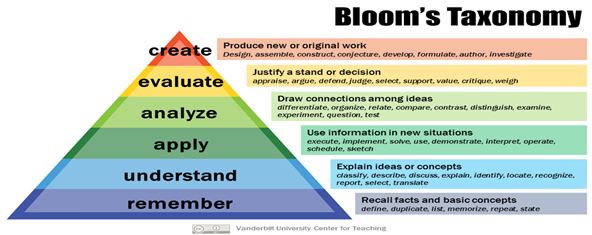The discussion board is certainly not new to the online classroom. In fact, some may argue that the discussion board is one of the most well-known and used tools in online courses. While the discussion board is ubiquitous within the different Learning Management Systems (LMS) that exist, and is consistently included in online courses as a way to collect formative assessment data and engage students, its use could be elevated by aligning Bloom’s Taxonomy of Educational Objectives (Anderson, Krathwohl, & Bloom, 2001) with discussion board prompts. Focusing on the cognitive knowledge domain, Bloom’s Taxonomy provides a hierarchical framework of learning outcomes that instructors can use to create more interactive, diverse, and impactful ways for students to experience deeper learning (Mehta & Fine, 2019) and meaningful discourse surrounding course content.

Remember
While remembering is the lowest level of Bloom’s Taxonomy, it is still important for students to be able to define and recall aspects of course content. Instead of asking students to respond to discussion board questions that are usually based on naming items that resonated with them after completing the readings, students could be asked to create an infographic using Canva or any other free tool. By sharing their learning on an infographic, the students can still demonstrate their ability to recall facts from the text, however, in an enhanced and creative way. In addition to having the opportunity to demonstrate their knowledge in a way that does not require the traditional typing of a response on a discussion board, students can get a chance to use a technology tool that may be useful to them in other assignments and courses. Once students create their infographic, they can upload the image directly to the discussion board for feedback from their peers and instructor.
Understand
At this stage, you want students to not only be able to retain and recognize content, but you also want students to demonstrate that they can translate and describe that content. In the remember stage, the aim was for students to simply state what they read. To know that students have a true understanding of the material, you may want to require students to classify and explain concepts as they relate to each other. Instead of asking students to type a response to general questions on the discussion board, you could have them create a mind map using a free tool such as Mindmeisterto show what they remember and how they are making sense of the interconnectedness of course concepts. Creating a mind map can also be helpful in students developing a deeper understanding of the course concepts at hand as it would provide a visual to go with the written text. With each student posting their individual mind map on the discussion board as their initial response, fellow students in the class can see how their peers are thinking about the course concepts, reflect on it, and develop a different understanding of how the concepts relate to each other. That new learning can be shared and used as follow-up responses on the discussion board.
Apply
At the application stage, students are expected to demonstrate and interpret. This is going beyond the understanding stage where students were required to simply report what they know, as is. On the discussion board in an online course, students could be asked to sketch a virtual venn diagram using a free tool such as Lucidchart. The venn diagram would compare and contrast the learned concept with another construct, demonstrating how students are using the learned information in new ways. Students would post their venn diagram directly to the discussion board and engage in discourse surrounding their individual application of learning.
Analyze
Asking students to analyze content requires them to organize, compare, and make connections between course content. A case study where students would be required to examine key components of the case, categorize the content, and question would be well suited at this stage, for the discussion board. With a traditional discussion board question, it is more difficult to get the type of responses that require differentiation and analysis that a case study would provide. To set up the case study within the discussion board, instructors can either write up a case study related to the week’s content or find one that is copyright free and would fit within the week’s discussion. The next step would be to post the case study directly to the discussion board and provide students with specific instructions in regard to analyzing and responding to the case study questions. Try to create case studies that would require students to go back into the text and use information to support their position.
Evaluate
The evaluation stage requires students to prioritize, justify, and decide. These are all attributes needed to effectively debate. In the discussion board, the instructor can post the makeup of debate teams, the topic to be debated, and a link to a shared collaborative space within the LMS for debate teams to prepare and meet virtually. The issues to debate would be crafted from the weekly or module course topic. The instructor could judge the debates, have a student judge, or have a panel of student judges. Once ready, the live debates can commence via a live discussion using video conferencing, or even recorded arguments could be posted to the discussion board. Be sure to rotate roles in different weeks or modules throughout the course so students will get the chance to be in the role of both debater and judge. Here are more tips on designing effective team projects in online courses.
Create
The creating stage is at the top of Bloom’s Taxonomy and involves designing, planning, and invention. At this stage, you can ask students to assemble, create or innovate a new product or concept as related to the week’s topic. The discussion board would be used for students to share the process and invention with recorded video responses. Instead of peers responding with the typical, “I agree” or “That is a good point,” they can offer alternatives to what their peers have created and substantiate their responses with newly formulated ideas.
Discussion boards can be more than the monotonous responding to questions about the weekly course readings. Learning objectives and opportunities for students to demonstrate their knowledge are all interconnected (Kulasegaram & Rangachari, 2018), regardless of where the course is carried out. By designing discussion boards to move students through Bloom’s Taxonomy, instructors not only can assess student learning in exciting and engaging ways, but they also provide students with diverse experiences with the discussion board. Since each discussion board will be new and unique, students will look forward to it, as opposed to it being just another item that they check off their list. Remember, discussion boards do not have to be done weekly. Keep the online course fresh and use different ways to connect learners with the content, with their peers, and with you. When you use discussion boards, ensure that the due date leaves time for review and feedback from instructors and peers. Provide creative guidelines for response postings and elevate the discussion board experiences for both your students and yourself!
Stephanie Smith Budhai is an associate professor of education at Neumann University with over a decade of experience teaching online courses. She is co-author of Best Practices in Engaging Online Learners through Active and Experiential Learning Strategies and editor of Online & Engaged: Innovative Student Affairs Practices for Online Learners. She holds a PhD in learning technologies and is certified in instructional technology.
References
Anderson, L. W., Krathwohl, D. R., & Bloom, B. S. (2001). A taxonomy for learning, teaching, and assessing: A revision of Bloom’s Taxonomy of educational objectives (Complete ed.). New York: Longman.
Kulasegaram, K. & Rangachari, P. K. (2018). Beyond “formative”: Assessments to enrich student learning. Advances in Physiology Education, 42, 5–14.
Mehta, J. & Fine, S. (2019). In search of deeper learning: The quest to remake the American high school). Cambridge, MA: Harvard University Press.






